| Author | Message | ||
| Henry D. Chin (Hanknum)
Junior Member Username: Hanknum Post Number: 226 Registered: 2-2002 |
Mark, I agree. | ||
| Mark Eberhardt (Me_k)
Member Username: Me_k Post Number: 735 Registered: 5-2002 |
Mitch and Henry, I agree to the point that as long as the car can move up it will and the spring force is exactly the same. I guess preload means nothing going straight . But the preload has increased and that means that when the car goes around a turn so the inside wheels are unloaded and the shocks extends, the suspension gets harsher as preload goes up because there is more force left pressing on the the spring collar. With really soft springs with a lot of preload (like a stock 308), it probably means nothing, but if you have stiff springs like on my car, 1" of preload puts 450 lbs of force on the unloaded wheel and makes the car just bang over mid-turn bumps. | ||
| Henry D. Chin (Hanknum)
Junior Member Username: Hanknum Post Number: 225 Registered: 2-2002 |
Yes, by adjusting the lower spring perch up it does increase the preload. But, this is a moot point. Let's assume that a 300#/in spring is 10 inches (free length). I install it on the shock and compress it to 9 inches. I have a preload of 300#. I then install it on the car and the weight of the car compresses it to 7 inches. The spring is "seeing" 900#. I adjust the lower spring perch up another inch and the top of the shock raises up an inch relative to the bottom of the shock, but it still only "sees" 900# (7 inches). The height of the body is raised and the spring stiffness has not changed. The preload does not come into play because the spring is compressed more than the initial preload. If there was no preload (lower spring perch adjusted so that it just touches the spring), the installed spring/shock would still see 900#. I am not a suspension expert, but I am a mechanical engineer, so I'm pretty much an expert on everything else ;-) Henry | ||
| Mitch Alsup (Mitch_alsup)
Intermediate Member Username: Mitch_alsup Post Number: 1116 Registered: 4-2002 |
Why not try an experiment. 1) get the car corner weighted. (all 4 corners) 2) raise/lower each corner by 5 turns on the adjuster 3) re-weight each corner. Result: each corner has the same weight as before*. Therefore, the height of the adjuster is not changing the preload on the spring. In fact, the compressed height of the spring is a function of a) the spring rate of the spring, b) the geometry of the linkages, c) weight on that corner of the car. * reason each corner has the same weight as before is that moving the wheels up and down does not change whare the center of gravity is with respect to the chassis. | ||
| Ben Cannon (Artherd)
Member Username: Artherd Post Number: 965 Registered: 6-2002 |
Peter- I think I see the issue now. Everyone- visualize a normal street car. When you COMPLETELY unload the suspension, usually the spring is still pushing on the shock, with some energy left to spare! (this is why you need a spring compressor to pull the springs out on most vehicles.) Let's say that the suspension completely unloaded, and WITH THE SHOCK BOTTOMED OUT, exerts 100lbs of force on the shock. In this case, Peter is actually correct, in that if you HAVE preload already, tightning the spring to force the shock to bottom out HARDER (ie 200lbs of static force when unloaded.) In this case, you are increasing both the preload, and the ride height, at the same time. Rob- I guess I'm one of those guys who lets the springs 'rattle, so when the spring is fully extended, the shock still has not bottomed out. Within this range, you can ajust suspension ride-height Ideally you should settle on a ride height, then get shocks that have ~50lbs or so of preload at that position, just to hold everything together. Best! Ben | ||
| peter james moran (Pjm)
Junior Member Username: Pjm Post Number: 72 Registered: 3-2002 |
Jay you are right in one case - the only way to change the spring rate is to change the spring. But if you have a spring that is 10" long and rated a 400 lbs. it will take X amount of energy to hold that spring at 8.5"- I.E. when you tighten the collar or the weight of the car on it. When you tighten the collar beyond the static spring lenght it becomes preloaded. | ||
| Jay Morris (Jm3)
Junior Member Username: Jm3 Post Number: 51 Registered: 10-2002 |
Sorry, raising and lowering an adjuster does not change the spring rate. It just does not have anything to do with it. Springs rate only has to do with pounds per inch. A 300 pound per inch spring will take 300 lbs of force to move it the first inch, another 300 lbs for the second inch, and so on. When a threaded adjuster, or anything pushes up on the bottom of a _static_ spring, the spring does not store energy, it just pushes upward with the same force as before, because the weight on top of the spring hasn't changed. | ||
| Steve Magnusson (91tr)
Intermediate Member Username: 91tr Post Number: 2131 Registered: 1-2001 |
peter -- Can you draw/post a simple diagram/layout of the mechanical mechanism you're describing (we might be talking apples and oranges here)? I'd agree that raising the lower spring perch on a coil-over-Koni "puts more energy into it" (the spring) in the fully unloaded condition, but in the operating position the energy stored in the spring is the same regardless of the lower perch position on the F double A-arm + coil-over-Koni layout (and the effective wheel spring rate is unchanged IMO). Can you clarify? | ||
| peter james moran (Pjm)
Junior Member Username: Pjm Post Number: 71 Registered: 3-2002 |
This will be my last post on the subject. A shock is X length unloaded. If a car weighed nothing (0 lbs.), the shock would not compress when you put the weight of the car on it. It would remain its unloaded length. But cars (and motorcycles) do weight something. Let's say a Ferrari 308 for example is 3000 lbs. (approximately). If you put the 3000 pound Ferrari on the ground the load will be distributed to all four shocks. Each shock will carry a percentage of the load. While caring this load the shock will compress a small amount. The difference between the length of the shock loaded and unloaded is the "sag". Sag is adjusted by turning the collar the and this is referred to as adjusting the preload. Tightening the spring will compress the spring and put more energy into it � lifting the car and reducing the "sag" dimension and stiffen the suspension as well. Note: If you had enough treads for the collar to turn you could compress the spring until the coils bound upon themselves, but the length of the shock will not change at that point, but the shock will be containing a lot of energy. Loosening the collar will reduce the springs� energy increasing the shock sag number - lowering the car and softening the softening the suspension. Note: The spring will always carry the load of the car until (again with enough threads) you loosen the collar so much that the shock (not the spring) would compress until it used up all of its travel. The difference between cars and motorcycles regarding sag is: because the car to driver weight ratio is so small that USUALLY you don't get too concerned with setting the sag with the driver in it, unless -because the rider to motorcycle weight ratio is so great close to 40% in some cases you measure the sag with the rider on the bike. You do this with someone hepling hold the bike upright and steedy while its measured as the stand would carry part of the load and give a false number. Your on your own from here. Cheers, Peter PS Thanks, Henry for sharing this project with us, and trust me on this suspension stuff :-) | ||
| Henry D. Chin (Hanknum)
Junior Member Username: Hanknum Post Number: 223 Registered: 2-2002 |
Rob - Thanks for the compliment. I think we all know your wealth of knowledge in suspensions and I appreciate it. Peter - Whatever, way too long and I've lost interest. | ||
| Jay Morris (Jm3)
New member Username: Jm3 Post Number: 50 Registered: 10-2002 |
Cars are different from motorcycles, especially in terms of suspension droop, and therefore preload. A motorcycle is often tuned without the rider compressing the springs, so even if on a sidestand, it is possible for spring height to become preload.(until the rider gets on the bike) A car is completely different. Think of it this way: The only thing that holds down the top of the spring is the weight of the car. When you push the bottom of the spring up, the spring then pushes the car up. Therefore, when you thread the adjuster up, the car is raised. Jay Morris | ||
| peter james moran (Pjm)
Junior Member Username: Pjm Post Number: 70 Registered: 3-2002 |
Henry and Ben, With all due respect I'm not wrong perhaps you are misunderstanding something I wrote. I'm not going to get in a fight here about what "preload" is. I suggest you look into working with a suspension expert before jumping to conclusions. Suspension takes a while to understand. The following is information and notes that I compiled during 12 years of competitive racing. It was on motorcycles, but don't jump to conclusions because most of the information is very relevant and applicable to cars. It might be fun reading for some so enjoy� Regards, Peter Suspension - Street Bike or Road Racing Applications Compiled by Peter J. Moran, pjmDesigns With incorrect suspension setup, tire wear is increased and handling suffers, resulting in rider fatigue. Lap times can be dramatically slower and overall safety for both street and race enthusiasts is another issue. Add the frustration factor and it just makes sense to properly setup your suspension. The following guide will help you dial in your suspension for faster and safer riding both on and off the track. Basic Setup Check the following: . Forks sag: 25-40 mm . Shock sag: 25-35 mm . Chain alignment - If not correct, bike will crab walk and sprocket wear will be increased. . Proper tire balance and pressure - If out of balance, there will be vibration and headshake. . Steering head bearings and torque specifications - If too loose, there will be head shake at high speeds. . Front-end alignment - Check wheel alignment with triple clamps. If out of alignment, fork geometry will be incorrect and steering will suffer. . Crash damage - check for proper frame geometry. Adjustment Locations on Forks . Rebound adjustment (if applicable) is located near the top of the fork. . Compression adjustment (if applicable) is located near the bottom of the fork. . Spring preload adjustment (if applicable) is generally hex style and located at the top of the fork. Forks: Lack of Rebound Symptoms: - Aggressive input at speed lessons control and chassis attitude suffers. - Front end fails to recover after aggressive input over bumpy surfaces. - The motorcycle wallows and tends to run wide exiting the turn causing fading traction and loss of control. - When taking a corner at speed, you experience front-end chatter, loss of traction and control. - Forks are plush, but increasing speed causes loss of control and traction Solution: Increase rebound "gradually" until control and traction are optimized and chatter is gone. Forks: Too Much Rebound Symptoms: - Front end feels locked up resulting in harsh ride. - Suspension packs in and fails to return, giving a harsh ride. Typically after the first bump, the bike will skip over subsequent bumps and want to tuck the front. - With acceleration, the front end will tank slap or shake violently due to lack of front wheel tire contact. Solution: Too much rebound. Decrease rebound "gradually" until control and traction are optimized. Forks: Lack of Compression Symptoms: - Front-end dives severely, sometimes bottoming out over heavy bumps or during aggressive breaking. - Front feels soft or vague similar to lack of rebound. - When bottoming, a clunk is heard. This is due to reaching the bottom of fork travel. Solution: Insufficient compression. Increase "gradually" until control and traction are optimized. Forks: Too Much Compression Symptom 1: - Front end rides high through the corners, causing the bike to steer wide. It should maintain the pre-determined sag, which will allow the steering geometry to remain constant. Solution: Decrease compression "gradually" until bike neither bottoms or rides high. Symptom 2: - Front end chatters or shakes entering turns. This is due to incorrect oil height and/or too much low speed compression damping. Solution: First, verify that oil height is correct. If correct, then decrease compression "gradually" until chattering and shaking ceases. Symptom 3: - Bumps and ripples are felt directly in the triple clamps and through the chassis. This causes the front wheel to bounce over bumps. - Ride is generally hard, and gets even harder when braking or entering turns. Solution: Decrease compression "gradually" until control is regained. Shock: Lack of Rebound Symptom: - The ride will feel soft or vague and as speed increases, the rear end will want to wallow and/or weave over bumpy surfaces and traction suffers. - Loss of traction will cause rear end to pogo or chatter due to shock returning too fast on exiting a corner. Solution: Increase rebound until wallowing and weaving disappears and control and traction are optimized. Shock: Too Much Rebound Symptom: - Ride is harsh, suspension control is limited and traction is lost. - Rear end will pack in, forcing the bike wide in corners, due to rear squat. It will slow steering because front end is riding high. - When rear end packs in, tires generally will overheat and will skip over bumps. - When chopping throttle, rear end will tend to skip or hop on entries. Solution: Decrease rebound "gradually" until harsh ride is gone and traction is regained. Decrease rebound to keep rear end from packing. Adjustment Locations on Shocks Rebound adjustment (if applicable) is located at the bottom of the shock. Compression adjustment (if applicable) is located on the reservoir. Spring preload is located at the top of the shock. Shock: Lack of Compression Symptom: - The bike will not turn in entering a turn - With bottoming, control and traction are lost. - With excessive rear end squat, when accelerating out of corners, the bike will tend to steer wide. Solution: Increase compression "gradually until traction and control is optimized and/or excessive rear end squat is gone. Shock: Too Much Compression Symptoms: - Ride is harsh, but not as bad as too much rebound. As speed increases, so does harshness. - There is very little rear end squat. This will cause loss of traction/sliding. Tire will overheat. - Rear end will want to kick when going over medium to large bumps. Solution: Decrease compression until harshness is gone. Decrease compression until sliding stops and traction is regained. Stock Tuning Limitations The factories plan on designing a bike that works moderately well for a large section of riders and usages. To accomplish this as economically as possible, manufacturers install valving with very small venturis. These are then matched to a very basic shim stack which creates a damping curve for the given suspension component. At slower speeds this design can work moderately well, but at higher speeds, when the suspension must react more quickly, the suspension will not flow enough oil, and will experience hydraulic lock. With hydraulic lock, the fork and/or shock cannot dampen correctly and handling suffers. The solution is to re-valve the active components to gain a proper damping curve. It does not matter what components you have, (Ohlins, Fox, KYB, Showa), matching them to your intended use and weight will vastly improve their action. Furthermore, if you can achieve the damping curve that is needed, it does not matter what brand name is on the component. Often with stock components, when you turn the adjusters full in or out, you do not notice a difference. In part, this is due to the fact that the manufacturer has put the damping curve in an area outside of your ideal range. Also, because the valves have such small venturis, the adjuster change makes very little difference. After re-valving, the adjusters will be brought into play, and when you make an adjustment, you will be able to notice that it affects the way the way the fork or shock performs. Another problem with stock suspension is the springs that are used. Often they are progressive, increasing the spring rate with increased compression distance. This means that the valving is correct for only one part of the spring's travel, all other is compromise. If the factory does install a straight-rate spring, it is rarely the correct rate for the weight of the rider with gear. The solution is to install a straight-rate spring that matches the valving for the combined weight of the bike, rider and gear to the type of riding intended. Remember . Always make small adjustments, more is not always better. . Always keep notes. . Suspension tuning is an art, be patient. | ||
| Rob Schermerhorn (Rexrcr)
Member Username: Rexrcr Post Number: 825 Registered: 11-2002 |
I agree, though with the caveat of large spring rates. OTOH, ALL road cars, including Ferrari's, run pre-loaded springs. This keeps them from rattling at full droop. Manufacturers get away with this because the OEM rates are low, and the weight of the car continues to compress the spring at static ride height. So one can do the same when increasing spring and damping rates for a sportier ride and roll rate, but only to a point. When the vehicle weight can no longer compress the spring in a static condition, one must either get custom wound springs to specific length, allow them to rattle at droop (not desirable, but most racers do this) or add a supplemental spring which is at coil bind when the vehicle's in a static condition. BTW, Henry, nice job. | ||
| Mark Eberhardt (Me_k)
Member Username: Me_k Post Number: 726 Registered: 5-2002 |
Oh, the change in hieght with and without wieght on the wheels is sag and if a function of both spring rate and preload. I guess the general rule the car should sag about 1/3-1/2 it's designed suspension travel. I like to set street cars up with about 5" of travel, so 1.75 - 2.5" of sag. If you have more total travel, you should have more sag. | ||
| Mark Eberhardt (Me_k)
Member Username: Me_k Post Number: 725 Registered: 5-2002 |
I'm going to have to side with Peter on this one. Pre-load in the force from the spring when the shock is fully extended. It is the (spring free length-installed length) x spring rate. The more you turn the collar to raise the car, the more preload you have and the stiffer the suspension. It's a pretty common misunderstanding that the spring collar is intended to adjust ride height because adjusting it does affect the ride hieght. Making small changes that way is fine I guess, but it does change the suspension. To adjust the ride hieght without affecting the suspension rates, you need to adjust the shock length or it's mounting locating. I like to keep preload pretty low, I use 1/4" or about 100 lbs on my shocks, which is why I get away with such heavy springs (450f/400r)on the street. When I was happy with the way the suspension felt, I sent the shocks back and had length adjusted to give me the ride hieght I wanted. I guess if the spring is relatively light, adjusting ride hieght a little with the spring isn't so bad, but if you're talking about inches, well.... | ||
| Ben Cannon (Artherd)
Member Username: Artherd Post Number: 961 Registered: 6-2002 |
Peter- sorry, but you're flat wrong. Within the linear movement range of the suspension, you may ajust ride height by relocating the lower spring perch with respect to the shock (assuming said shock is fixed to the unsprung hub.) Pre-load would only happen if you exceeded the shock's travel, in general, a VERY BAD idea (because the wheel could no longer "drop" to "fill" a pothole. | ||
| Henry D. Chin (Hanknum)
Junior Member Username: Hanknum Post Number: 222 Registered: 2-2002 |
Dave - I have not measured the actual suspension travel now. The front shocks have a compressed length of 10-1/8 to an extended length of 14". The rears are 11-5/8 to 17" Peter - No, the stiffness does not change. The compressed length of the spring does not change (until it is compressed to the point of full extension of the installed shock), thus there is no additional potential energy added to the spring. | ||
| Mark Eberhardt (Me_k)
Member Username: Me_k Post Number: 723 Registered: 5-2002 |
I've got really stiff springs (450F/400r)on a GTS. The only difference I noticed was that the car handled a lot better, but I think that was the shocks as much as the springs. | ||
| peter james moran (Pjm)
Junior Member Username: Pjm Post Number: 69 Registered: 3-2002 |
Henry, Yes the car will raise when you compress the spring with the collar, but you are stiffening the suspension, too. More energy is being held in the spring the more you tighten the collar hence the spring has more power/energy to lift the car. Pre load is determined in a measurement of length or distance. The Length of the shock with and without the weight of the car on it. Regards, Peter | ||
| Dave White (Dwhite)
Junior Member Username: Dwhite Post Number: 125 Registered: 5-2003 |
Henry, How much travel do you have in the suspension now? | ||
| Bert Kanters (Bert308)
Junior Member Username: Bert308 Post Number: 129 Registered: 11-2002 |
Anybody who lowered and stiffened the suspension on a GTS can comment on how the roofless body is reacting to the greater forces? Scuttle shake, does the body make a stressed impression? Doors keep locked tight? | ||
| Henry D. Chin (Hanknum)
Junior Member Username: Hanknum Post Number: 220 Registered: 2-2002 |
Wolfgang - Thanks, your car looks great. Peter - Adjusting the lower spring perch will adjust the height of the body. The only preload on the springs is the weight of the car. The adjustment knob will control both compression and rebound. Everyone - I did this project over the last couple months, since I have a lot more time on my hands now. I haven't worked since March (tears should start to well up about now). I considered putting a package together and selling it, even at a considerable discount to what another place is selling this set up for. I figured I could make a few bucks, but I guess it just didn't feel right. If any of you are compelled after reading this, you can donate to Henry's Unemployment Fund. As I stated in a previous post, I have been considering this for a couple of years now. I went through all the options...cutting springs, euro springs, custom springs, lowering perch, new groove in shock body, adding adjustable collar to shock body and anything else I could think of. In the end this was the most economical for me. The shocks and springs are from QA1. This company specializes in circle track racing I believe. I had many conversations with their engineering dept. These I believe are not in the same league as Ohlins, but they didn't cost me $3000 either. Here are the specifics: Front shocks: HAL-4855P Rear shocks: HAL-5855P Front spring: HAL-10-300 (10" spring, 300 #/in) Rear sping: HAL-12-250 (12" spring, 250 #/in) The factory Konis are 46mm wide at each mounts and the QA1 are only 32mm wide, so I just added washers on both sides. The best thing to do would probably make up sixteen 7mm spacers out of aluminum. My initial drive after installing this set up was from Ventura to Monterey for the Concours Italiano (up PCH). The car handles much better, less body roll and nicely firm. Previously, it seemed to wallow a lot more in the turns. The shocks have 12 settings and I'm on #4 (12 being the firmest). I'm sure I left out a bunch of stuff, so if you have any more questions, just post them here or call me @ (805) 644-0055. BTW, I ordered all my stuff through Summit Racing, great people to deal with. Thanks Henry | ||
| peter james moran (Pjm)
Junior Member Username: Pjm Post Number: 68 Registered: 3-2002 |
Hi Henry, What brand are they. Turning the collar at the base of the spring would only adjust the pre-load. That adjustment would translate to stiffer Vs softer. I see the one adjuster knob does that control both rebound and compression or is there another adjustment location? Also what spring rate did you get? I've been considering Ohlins, but this looks like a good economical solution. Regards, Peter | ||
| Jerry W. (Tork1966)
Member Username: Tork1966 Post Number: 983 Registered: 7-2001 |
No problem whatsoever with streets. I know my town well enough that I know where the big bad "dips" are. Obviously I can't go up any steep parking lot entrances (at least not straight on). Actually, with the stiffer springs (which I love), the car is not as "mushy" as it used to be so bumps are now actually LESS of a problem. I absolutely love the ride, feel and look after lowering. I think it is the single best thing that I've done to the car. | ||
| Wolfgang Eistert (53345)
Member Username: 53345 Post Number: 771 Registered: 3-2003 |
Hi Henry, well, well done! 2 years ago, I have lowered my 308QV `85 and set up with spacers, F348 17" wheels, 215 front & 2rear. Not only optical - the handling is much better! Wolfgang FORZA FERRARI 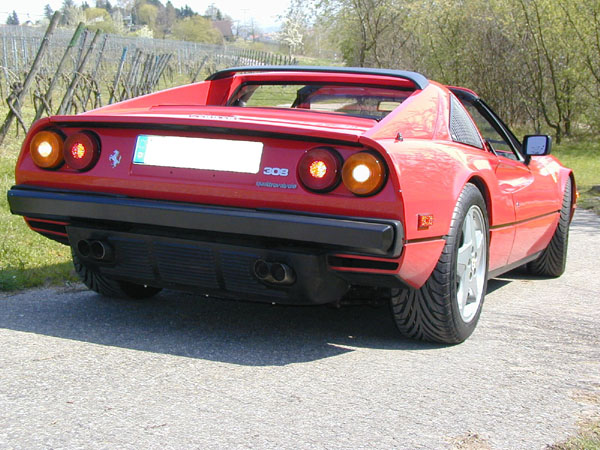 | ||
| Henry D. Chin (Hanknum)
Junior Member Username: Hanknum Post Number: 218 Registered: 2-2002 |
Mike - To adjust the ride is just a matter of loosening the lock ring under the lower spring perch and adjust and retighten. Ron - Thanks. I'll try and post some pix of the seats in the next couple days. They are Corbeau seats. BTW, you've got a very keen eye. David et. al. - I'll gather all my info and post all the details tomorrow, promise. Henry | ||
| Ron Thomas (Ronsupercar)
Intermediate Member Username: Ronsupercar Post Number: 1053 Registered: 5-2002 |
Henry. I love how the car looks.. Definitly a worthy upgrade.. I see you've changed your seats.. Please post some pics of that too.. Jerry You lowered your car too.. Does it make it difficult to drive w/the euro spoiler on there. Are the streets that smooth where you are.  | ||
| Mike Charness (Mcharness)
Intermediate Member Username: Mcharness Post Number: 1017 Registered: 8-2002 |
Henry: Do you adjust the ride height now just by turning a knob without doing any disassembly? | ||
| Henry D. Chin (Hanknum)
Junior Member Username: Hanknum Post Number: 216 Registered: 2-2002 |
Thanks for the compliments guys. I'll post more details tomorrow, when I have a little more time. Jerry, I wish my suspension was as clean as yours. Tom, I've been working on this on & off for a couple years now...I feel your pain. Frank, Actually, I don't think the 308's are among the lowest Ferraris. I do know that the 308 does appear to have some of the largest gaps between the tire and wheel well though. I ended up lowering the body in front by about 2" and the rear about 1.5". I'm going to raise both ends about .5" (I bottomed out a couple of times). | ||
| Frank Wiedmann (Frankieferrari)
Member Username: Frankieferrari Post Number: 337 Registered: 8-2003 |
Henry, Our 308's are already,I believe,the lowest Ferrari.(one of them,anyway,not counting race cars!) What is the new,lower roof height of your car,now? | ||
| Tom Bakowsky (Tbakowsky)
Member Username: Tbakowsky Post Number: 628 Registered: 9-2002 |
Interesting how I made a thread regarding this very upgrade and nobody seemed to wanna give up the info. Now about a month later here is some pictures and about 6 replys asking for info. WTF? | ||
| dave handa (Davehanda)
Intermediate Member Username: Davehanda Post Number: 1867 Registered: 5-2001 |
Yes, details please of vendor, and spring rates please.... | ||
| ARIE BONSELAAR (Arie)
Junior Member Username: Arie Post Number: 75 Registered: 5-2001 |
very very nice! could you post a few more pics, I cant wait till i lower mine, thanks | ||
| Jaime T. Ferraris are sex on wheels (Chevarri)
Junior Member Username: Chevarri Post Number: 175 Registered: 1-2003 |
The 308 looks so much nicer lowered, xlt job and your undercarriage looks nice too! | ||
| Jerry W. (Tork1966)
Member Username: Tork1966 Post Number: 978 Registered: 7-2001 |
That looks awesome Henry! The shocks are too cool!! It completely changes the looks of the car. Here is a photo of mine after I put on new springs and had the rotors and calipers zinc plated and the a-arms urethane painted. Jerry. 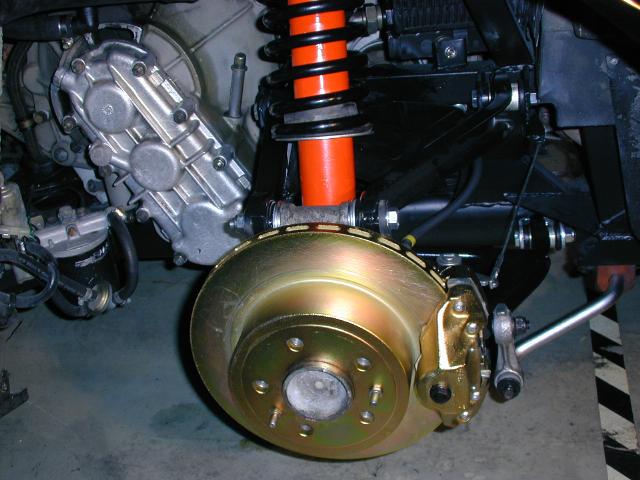 | ||
| David Feinberg (Fastradio2)
Member Username: Fastradio2 Post Number: 382 Registered: 4-2002 |
Nice set-up! Who makes the coilovers? David | ||
| Henry D. Chin (Hanknum)
Junior Member Username: Hanknum Post Number: 215 Registered: 2-2002 |
Well the project is mostly complete. I have replaced the stock Konis on my '78 308 GTS/B/O with aluminum bodied adjustable coilovers. The ride height and compression & rebound are fully adjustable. The best thing about this set up is that it was about $800. I still need to replace the control arm bushings, fine tune, and then have the whole thing aligned. Here are some before and after pix: 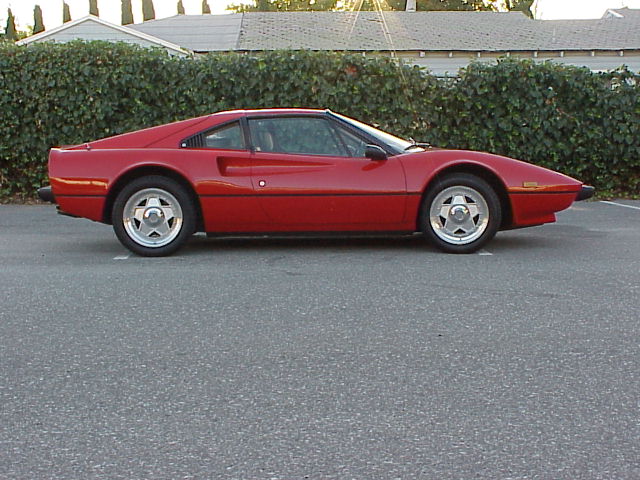 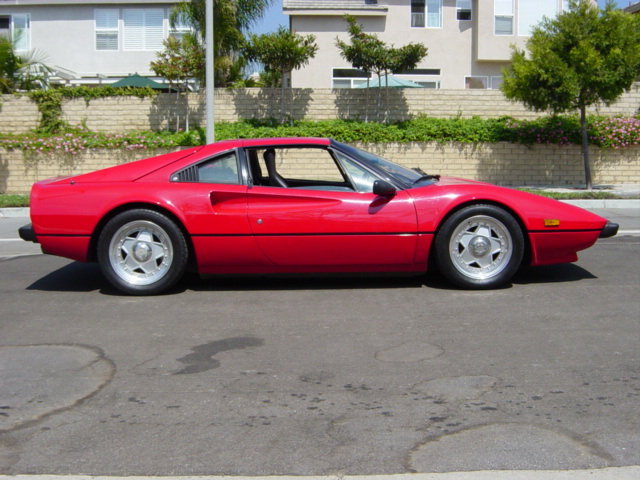 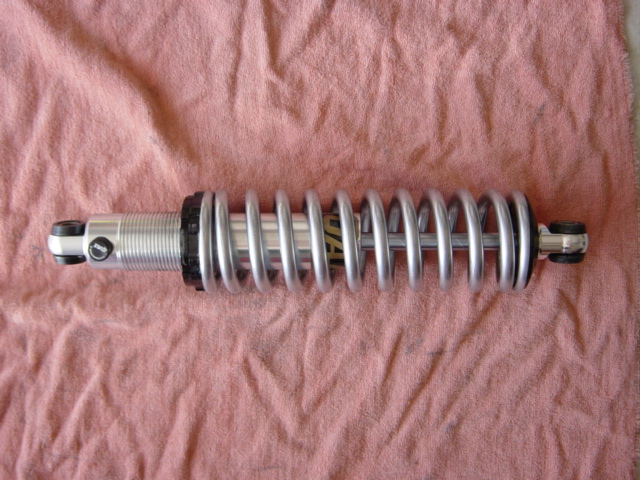 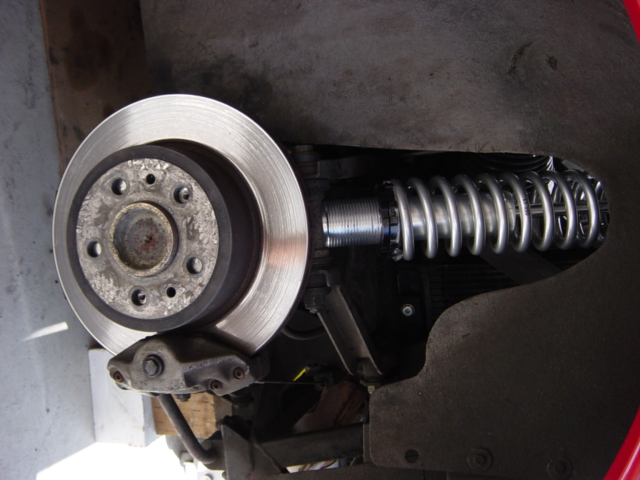 |